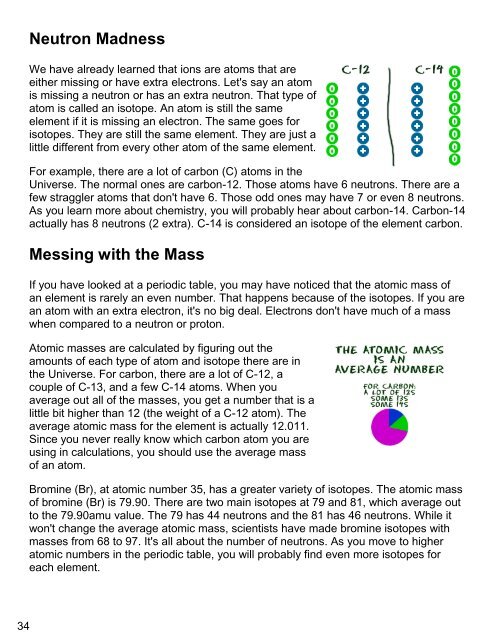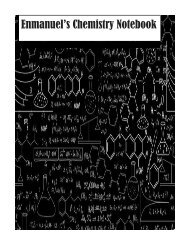You also want an ePaper? Increase the reach of your titles
YUMPU automatically turns print PDFs into web optimized ePapers that Google loves.
Neutron Madness<br />
We have already learned that ions are atoms that are<br />
either missing or have extra electrons. Let's say an atom<br />
is missing a neutron or has an extra neutron. That type of<br />
atom is called an isotope. An atom is still the same<br />
element if it is missing an electron. The same goes for<br />
isotopes. They are still the same element. They are just a<br />
little different from every other atom of the same element.<br />
For example, there are a lot of carbon (C) atoms in the<br />
Universe. The normal ones are carbon-12. Those atoms have 6 neutrons. There are a<br />
few straggler atoms that don't have 6. Those odd ones may have 7 or even 8 neutrons.<br />
As you learn more about chemistry, you will probably hear about carbon-14. Carbon-14<br />
actually has 8 neutrons (2 extra). C-14 is considered an isotope of the element carbon.<br />
Messing with the Mass<br />
If you have looked at a periodic table, you may have noticed that the atomic mass of<br />
an element is rarely an even number. That happens because of the isotopes. If you are<br />
an atom with an extra electron, it's no big deal. Electrons don't have much of a mass<br />
when compared to a neutron or proton.<br />
Atomic masses are calculated by figuring out the<br />
amounts of each type of atom and isotope there are in<br />
the Universe. For carbon, there are a lot of C-12, a<br />
couple of C-13, and a few C-14 atoms. When you<br />
average out all of the masses, you get a number that is a<br />
little bit higher than 12 (the weight of a C-12 atom). The<br />
average atomic mass for the element is actually 12.011.<br />
Since you never really know which carbon atom you are<br />
using in calculations, you should use the average mass<br />
of an atom.<br />
Bromine (Br), at atomic number 35, has a greater variety of isotopes. The atomic mass<br />
of bromine (Br) is 79.90. There are two main isotopes at 79 and 81, which average out<br />
to the 79.90amu value. The 79 has 44 neutrons and the 81 has 46 neutrons. While it<br />
won't change the average atomic mass, scientists have made bromine isotopes with<br />
masses from 68 to 97. It's all about the number of neutrons. As you move to higher<br />
atomic numbers in the periodic table, you will probably find even more isotopes for<br />
each element.




